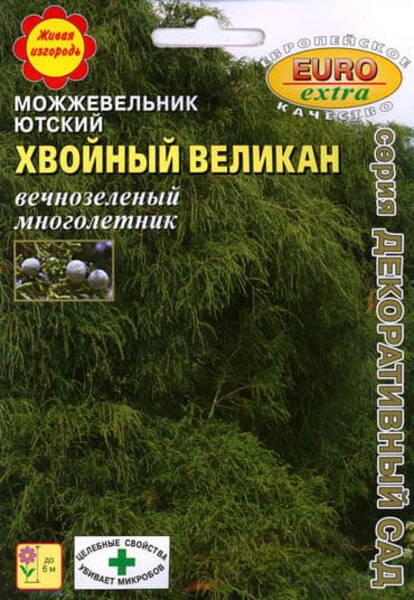Your shopping cart is empty!
Utah-Juniper "Hvoiny Velikan"
Utah-Juniper "Hvoiny Velikan".
Evergreen shrub or tree: monoecious, 6 m tall, multi-stemmed or single-stemmed. The bark is scaly, with gray-brown stripes. The branches are wide ascending, straight, 3-4 sided, cruciform in cross section, wide, long with scaly leaves. The leaves are light yellow-green directed away from the axis, the glands are inconspicuous or absent, finely serrated along the edge, 0.3-0.5 cm long, with a gray-blue coating, overlapping or not (with a keel), the apex is rounded, acute or occasionally obtuse, pressed. Fruits are stalked, round, 0.8-0.9 cm, bluish-brown with a gray-blue bloom.
Recommended for landscape gardening, creating hedges and green compositions.
Agricultural technology.
It is winter-hardy, drought-resistant, photophilous, undemanding to the soil, resistant to smoke and gases, has soil-protective properties. Due to the rooting of the branches lying on the surface of the soil, it quickly grows in width, forming dense thickets.
Grows on calcareous or rocky soils. Undemanding to fertility and soil moisture, but does not tolerate dry air.
Seeds are stratified before sowing. Should be planted in sunny places. In the shade, the plants grow loose and lose the decorative dignity of the form.
One juniper bush in 10 years covers an area of 20 m2.
The distance between plants is from 0.5 to 1.5 m.
Planting depth 70 cm - with earth filling in the pit.
Drainage: broken brick and sand, 15-20 cm layer.
Soil mixture: peat, soddy soil, sand (2:1:1), react positively to soil liming.
Leaving: in the spring in April - May bring nitroammophoska, 30-40 g/sq.m.
In dry summers, it is recommended to water 2-3 times per season and spray once a week in the evening. Loosening, mulching is carried out shallow after watering and weeding in young plantings. Mulching with peat, wood chips or sawdust in a layer of 5-8 cm immediately after planting. Haircut, pruning is weak, as junipers grow slowly. Mostly dry branches are removed. In the first winter after planting, young plants are covered.
Evergreen shrub or tree: monoecious, 6 m tall, multi-stemmed or single-stemmed. The bark is scaly, with gray-brown stripes. The branches are wide ascending, straight, 3-4 sided, cruciform in cross section, wide, long with scaly leaves. The leaves are light yellow-green directed away from the axis, the glands are inconspicuous or absent, finely serrated along the edge, 0.3-0.5 cm long, with a gray-blue coating, overlapping or not (with a keel), the apex is rounded, acute or occasionally obtuse, pressed. Fruits are stalked, round, 0.8-0.9 cm, bluish-brown with a gray-blue bloom.
Recommended for landscape gardening, creating hedges and green compositions.
Agricultural technology.
It is winter-hardy, drought-resistant, photophilous, undemanding to the soil, resistant to smoke and gases, has soil-protective properties. Due to the rooting of the branches lying on the surface of the soil, it quickly grows in width, forming dense thickets.
Grows on calcareous or rocky soils. Undemanding to fertility and soil moisture, but does not tolerate dry air.
Seeds are stratified before sowing. Should be planted in sunny places. In the shade, the plants grow loose and lose the decorative dignity of the form.
One juniper bush in 10 years covers an area of 20 m2.
The distance between plants is from 0.5 to 1.5 m.
Planting depth 70 cm - with earth filling in the pit.
Drainage: broken brick and sand, 15-20 cm layer.
Soil mixture: peat, soddy soil, sand (2:1:1), react positively to soil liming.
Leaving: in the spring in April - May bring nitroammophoska, 30-40 g/sq.m.
In dry summers, it is recommended to water 2-3 times per season and spray once a week in the evening. Loosening, mulching is carried out shallow after watering and weeding in young plantings. Mulching with peat, wood chips or sawdust in a layer of 5-8 cm immediately after planting. Haircut, pruning is weak, as junipers grow slowly. Mostly dry branches are removed. In the first winter after planting, young plants are covered.
Eng.: Utah Juniper. Bot. syn.: Juniperus occidentalis var. utahensis (Engelm.), Juniperus utahensis var. megalocarpa (Sudworth), Sabina osteosperma (Torr.), Sabina utahensis (Engelm.).











